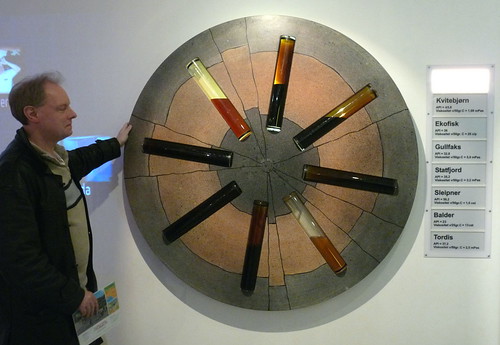Norwegian Power
10 Mar, 2009 06:40 pm
On the simple R/P ratio basis Britain has 6 years worth and Norway 9 years worth of North Sea oil. Norway does however have plenty of gas left, and exports 85 billion cubic metres of it to Europe annually. Norway is also almost self-sufficient in hydro-power which provides 98% of its electricity: enough for all its citizens and power-intensive industries.

I have just returned from a visit to the Norwegian capital of Oslo. This is a very cultural city, and at this time of year, cold, crisp snowy and quite beautiful. I had not seen much of the painter Edvard Munch's work before (apart from The Scream - Skrik - which has been the subject of a couple of high-profile robberies), but this is the place to see it. A Norwegian friend told me that in a crisis of faith, Munch simply stacked his canvases outside his house in all weathers, with birds messing on them. Now, of course, they are worth millions! Such is the fickle world of art. There is a good collection in the National Gallery and also in the Munch Museum. Like Vincent van Gogh, Munch's work seems to vibrate with a profound internal energy that seems to draw the viewer in, forging a connection with it. I am now a great fan of Munch, I must say.
There are just 4.8 million people living in Norway, more than 500,000 of them in Oslo. Despite its small population, compared to the U.K. which has around 60 million citizens, Norway has a land area of 385,000 km^2, or around half as much again as the British mainland. While Norway only ranks seventh in the list of world oil producers, it is reckoned to be third in the league-table of oil-exporting nations. Put another way, Norway produces a lot of oil and sells most of it, and is hence a very rich but expensive country; much of this wealth is invested into pension schemes and other means for social benefit. Hence, I believe it will become a magnet for those from other parts of the world seeking a better quality of life, as Britain has. Indeed, living in Britain now, Norway looks an attractive prospect to me.
Now Norwegian oil is not limitless, any more than our own UK provision is. It is reckoned, at least on a simple R/P ratio basis (which is a naive but crudely indicative analysis of relative resource holdings), that Britain has 6 years worth of oil left and Norway 9 years left. If you are in Oslo, a very hands-on place to visit is the Norsk Teknisk Museum, which is bit like our Science Museum in London, and which I preferred before it became thematic. I liked to be able to just wander around according to my own will. Nonetheless, the Norwegian technical museum also is arranged around themes of exhibition.
In the medical theme section, for example, is the treatment of lesions on the backs and limbs of children caused by tuberculosis, by focussing ultra-violet light from an exposed carbon-arc onto them. The apparatus is nakedly apparent. There are photographs of the nurses as they administered this treatment wearing goggles made from darkened glass. I suppose they had learned the hard way that ultraviolet light causes blindness, in fact by bleaching the cornea. There are also radiographs (x-ray photographs) of babies in the womb, taken at quite (I reckon 7 or 8 months) late stages of their confinement. The date 1897 seems to stick in my mind, when it was not known that radiation was harmful, until the radiographers began to suffer from cancers of their hands and fingers, necessitating the steady amputation of fingers, then hands and eventually arms, by when the subject likely had heavily invasive cancer. Death usually followed quickly, as for Thomas Edison's assistant, Clarence Daly who died aged just 38, after years of suffering, from handling x-ray tubes, finally with both arms amputated. What radiation dose the babies received is anyone's guess but it would have been large.
There is another theme on "Energy". The Norwegian industrial age began with the building of a hydroelectric power station and in consequence of its bestowal of waterfalls, the generating capacity from hydropower rose from 70 MW in 1906 to 1,270 MW in 1920. By 1970, all Norwegian homes were provided with electricity, and now some 98% of all Norway's electricity is made from hydropower, a total of 27.5 GW (27,500 MW). Norsk Hydro ASA, which began operating in 1905, is a Norwegian aluminium and renewable energy company, based in Oslo. It is the fourth largest integrated aluminium company worldwide and has outlets in 40 countries around the world and on all continents. The Norwegian State holds a 43.8 percent ownership interest in the company, with around 28,000 people on its payroll. Until October 2007, Norsk Hydro had a major presence in the oil and gas industry, until this division was merged with its rival Statoil to create StatoilHydro. StatoilHydro is the biggest offshore oil and gas company in the world and the largest company by revenue in the Nordic Region.
Before 1960, the huge oil resources off the long Norwegian coast were unknown, but U.S. exploration was successful in 1969 with the discovery of the first oil-field, Ekofisk. The Norwegian government allowed foreign companies rights to find and exploit the first of the Norwegian fields but thereafter demanded a strong presence and the subsequent take-over by new Norwegian companies like the state-owned Statoil. Very sensible of them!
Only time will confirm how much oil can be extracted form the North Sea, either under British or Norwegian territorial waters, but if Norway does have a mere 9 years of oil left, it still has plenty of natural gas, as was first discovered on the Norwegian continental shelf in the 1980's. Among the other wonders of the Teknisk Museum is an example of a gas-pipe, 42" in diameter, as is used to take gas from the Sleipner gas platform to Zeebrugger, as part of a gas-transportation network that moves 85 billion cubic metres of gas from Norway to Europe annually.
There is much negotiation about who will get new supplies of Norwegian gas, and whether some of it will come to the U.K. or go to mainland Europe. Most likely it will simply go to the highest bidder, and in these unpredictable economic times who that is, in the future, is anybody's guess.
Related Reading.
[1] http://en.wikipedia.org/wiki/Hydroelectricity#Countries_with_the_most_hydro-electric_capacity
[2] http://en.wikipedia.org/wiki/StatoilHydro
[3] http://en.wikipedia.org/wiki/Norsk_Hydro
[4] http://www.norsk-teknisk.museum.no/
-
12/12/12
“Peak Oil” is Nonsense… Because There’s Enough Gas to Last 250 Years.
-
05/09/12
Threat of Population Surge to "10 Billion" Espoused in London Theatre.
-
05/09/12
Current Commentary: Energy from Nuclear Fusion – Realities, Prospects and Fantasies?
-
04/05/12
The Oil Industry's Deceitful Promise of American Energy Independence
-
14/02/12
Shaky Foundations for Offshore Wind Farms







 Read more
Read more